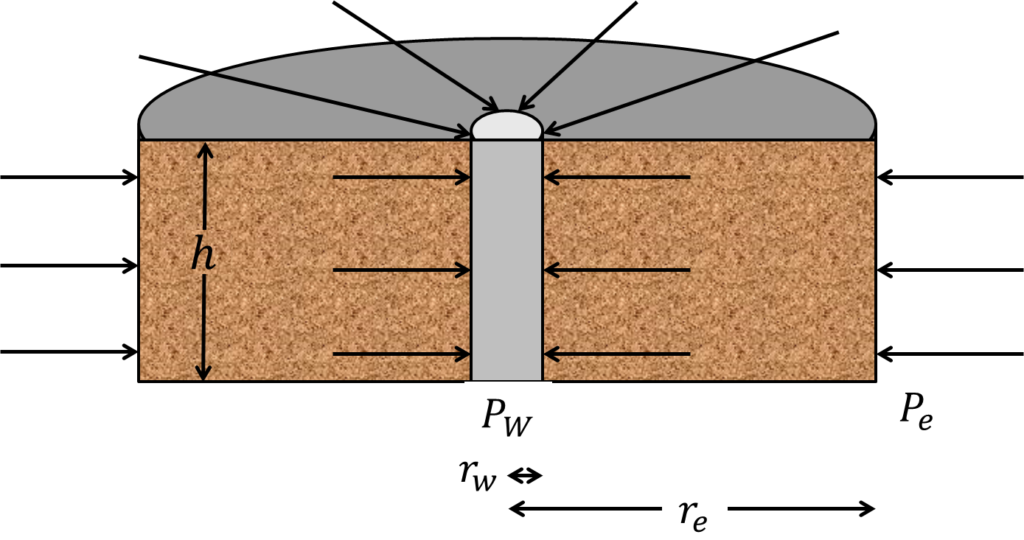Darcy’s law can be applied to model reservoir flow systems. The simplest is steady-state radial flow (steady-state just means that the flow rate and pressure does not vary with time). Consider the figure below:

In vertical wells, we often assume a cylindrial drainage area as depicted in the figure above. The flow is directed from the reservoir boundary to the wellbore. To model flow scenario, we apply Darcy’s Law:
STEP_1: Write Down Darcy’s Equation and define the variables
(Note: I excluded the negative. You’ll see why later)
![Rendered by QuickLaTeX.com \[ \frac{q}{A_c} =\frac{k}{u} \frac{dP}{dL} \]](https://topdogengineer.com/wp-content/ql-cache/quicklatex.com-0ad40c197cb186487390409f16075f9e_l3.png)
where:
![]()
For a cylindrical flow area.
STEP 2: Integrate by separation of variables
![Rendered by QuickLaTeX.com \[ \frac{q}{2\pi rh} = \frac{k}{u} \frac{dP}{dL} \]](https://topdogengineer.com/wp-content/ql-cache/quicklatex.com-e92c09da094db06bcad8e8469d33945f_l3.png)
![Rendered by QuickLaTeX.com \[ \frac{q}{r}dr = \frac{2\pi hk}{u} {dP} \]](https://topdogengineer.com/wp-content/ql-cache/quicklatex.com-aa6d71bdaf024a75d855e6e3149e19b1_l3.png)
![Rendered by QuickLaTeX.com \[ \int_{r_w}^{r_e}\frac{q}{r}dr = \frac{2\pi hk}{u} \int_{P_w}^{P_e}{dP} \]](https://topdogengineer.com/wp-content/ql-cache/quicklatex.com-7c514bec620d68a83b71659d28ac5f5f_l3.png)
![Rendered by QuickLaTeX.com \[ q[\ln{r_e}-\ln{r_w}] = \frac{2\pi hk(P_e-P_w)}{u}\]](https://topdogengineer.com/wp-content/ql-cache/quicklatex.com-7589ac5577c53f102913c205f9efdffc_l3.png)
STEP 3: Write the final expression
![Rendered by QuickLaTeX.com \[ \boxed{q = \frac{2\pi hk(P_e-P_w)}{u\ln{\frac{r_e}{r_w}}}}\]](https://topdogengineer.com/wp-content/ql-cache/quicklatex.com-99a67f17ac1af5753f25bc1686981790_l3.png)
By inspection (if you plug in some numbers), the negative sign is not needed because the flow rate will be positive, indicating that the fluid is flowing to the wellbore.